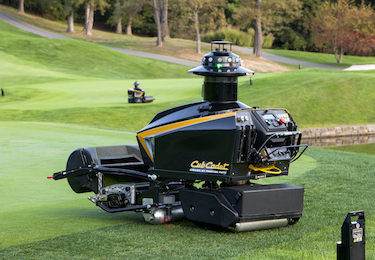Veteran reporter John Reitman, writing for TurfNet, shares how some golf courses in northern California have incorporated autonomous mowing technology.
A year after incorporating at the Presidio, Brian Nettz said putting conditions are better than ever.
There was a time when golf course superintendents could not envision entrusting putting surfaces to autonomous mowers. But 12 months after incorporating the technology into his day-to-day routine at the Presidio Golf Club in San Francisco, Brian Nettz cannot imagine ever going back to walk mowing greens.
For the past year, Nettz has been leasing a fleet of five Cub Cadet R3 mowers at the Presidio. The mowers help him save on labor and fuel costs and reduce the club’s environmental footprint.
As each autonomous unit mows greens, its “operator” is free to do things like rake bunkers and cup cuts. The units, each weighs in excess of 500 pounds, also roll as they mow, allowing allow five people to do more in one day than twice as many could accomplish a few days a week just one year ago. In fact, Nettz figures the units help save more than 70 labor hours per week. That’s a big deal with help becoming increasingly hard to find.
Historically, Nettz would have 15 people on staff, plus a mechanic. For the past few years, with help harder and harder to find, that number has been around 11. Based on that data, Nettz figures the units will offset the cost of a four-year lease in about two years.
“We’ve been trying to hire for three years, and there is nobody out there,” Nettz said. “This saves about 72 labor hours a week.”
The Presidio Golf Club is located in Presidio National Park. Any new machinery used on the property must be approved by the Presidio Trust, a federal agency that manages the park for the National Park Service. Incorporating equipment that uses a renewable energy source was an important consideration in one of the country’s environmental hotbeds, and made justifying the move to autonomous technology easier to defend.
“They are much more progressive than a board of directors at a country club. The environmental issues were a big driver,” Nettz said. “It’s all electric, which was in their wheelhouse of burning less fuel. We never really had to get into the justification of it.”
The units are controlled by a series of four beacons that recognize perimeter wires buried underneath the surface to map mowing patterns around each green.
The decision of lease vs. buy came down to staying current with improvements to the technology down the road.
“Why own them when the technology will be outdated in a couple of years?” he asked.
The hilly terrain at the Presidio and the mowers navigating slopes in morning dew was a concern, and once in a while a unit might need a push up a grade to get going.
Read it all here


